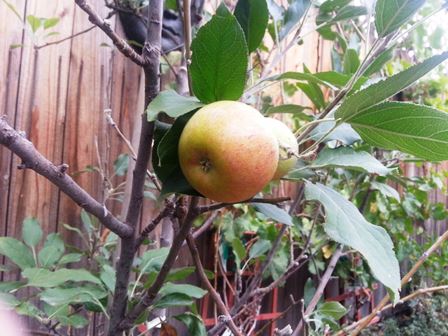Celebrating the Season of Apples
It’s that time of year when the scents of cinnamon and apple potpourri mingle with hot mulled cider. Thank you, Johnny Appleseed.
Or should I say, thank you, John Chapman (1174-1845). Born in Leominster, Massachusetts, Chapman planted apple orchards on lands in the northeastern and mid-western parts of the United States, returning after several years to sell those orchards after they were producing.
He also gave away many trees and seeds. But he didn’t believe in grafting, and the trees he planted bore apples more suited to cider. See, http://www.smithsonianmag.com/arts-culture/real-johnny-appleseed-brought-applesand-booze-american-frontier-180953263/?no-ist
It was John Chapman’s father Nathaniel–a farmer–who encouraged his son to become an orchardist. John planted more than a few orchards around the Midwest on lands he bought, owned, and sold. His life gave rise to the folk tradition of Johnny Appleseed. Today, there are many festivals that honor his life and work as well as a U. S. postage stamp.
Today, you don’t need a lot of land to grow an apple tree or two. Even a small piece of land can accommodate the fruit tree, thanks to the availability of dwarf and semi-dwarf varietals. Apartment dwellers and people who have limited space can even espalier an apple tree against a wall.
On the Henny Penny Farmette, we are growing the thin-skinned Cox Orange Pippin dessert apple, among others. This late-season varietal was first grown in 1825 in Colnbrook in Buckinghamshire, England. The flesh is orangey-red and the flavor is sweet and nutty. These apples can be eaten fresh, used in recipes, or made into cider.
If you have some cider on hand and would like to create the mulled apple cider flavor, add a couple of cinnamon sticks, a teaspoon each of whole cloves and allspice with a half-gallon of cider and heat in a saucepan. Add a little orange juice or some slices of orange. After simmering for 8 to 10 minutes, strain the mulled cider into mugs. Consider making a batch of farmhouse doughnuts to accompany the cider.
FARMHOUSE DOUGHNUTS
Ingredients:
1 pkg. yeast
1 cup lukewarm milk
1/2 teaspoon salt
31/2 cups flour
1/4 cup canola oil, plus oil for frying
1 cup brown sugar
2 eggs, well beaten
3/4 teaspoon nutmeg
Directions:
Mix together the yeast and milk in a small bowl.
Combine flour with salt in a large bowl.
Add the yeast and milk to the flour and salt mixture and beat well.
Let the mixture rise for one-half hour.
Add all the other ingredients and beat well again.
Let rise for one hour.
Punch down the dough. If it appears too soft to roll out, add more flour.
Turn the dough out onto a well-floured board and let the dough rest for ten minutes.
Divide the dough in half. Roll one section of dough out to 1/2 inch thickness and cut with a doughnut cutter. Repeat the process for the other half of the dough.
Let the doughnuts rise for about an hour; fry in oil at 360 degrees Fahrenheit. When the doughnut has turned brown, flip over. Take care not to burn.
Remove from doughnuts from hot oil and drain on paper towels.
Place doughnuts in a bag with granulated sugar and shake to coat. Makes approximately two dozen doughnuts and holes.
Cape Honeysuckle Provides Blazing Color in Winter Gardens
Throughout the fall and winter in Northern California gardens, when summer blooms have disappeared and spring is still several months away, the flower clusters of Cape honeysuckle add brilliant orange-red color to drab landscapes. This climbing evergreen vine can reach 15 to 25 feet and looks stunning spilling over a fence. It can also be trained to cover a trellis or an arch. With vigorous pruning, the plant can be kept to a shrub of six to eight feet.
The name Cape honeysuckle refers to South Africa’s Cape Horn where the plant is indigenous. The name, therefore, misleads for the plant does not belong the true honeysuckle family (Lonicera).
Gardeners value the plant for its landscaping qualities that include brilliantly colored tubular flowers against fine, glistening green foliage. The plant is a rapid grower and can tolerate some drought although it needs good drainage. Vines that lie on the ground can root. The plant can also be grown from seed or cuttings.
I’ve found Cape honeysuckle to tolerate the sometimes harsh conditions of summer here on the farmette that might include days of triple digit outdoor temperatures and occasional high winds. The plant needs water in extreme heat, but once established seems vigorous and hardy.
Keep your pruning shears handy. I previously grew Cape honeysuckle in my San Jose garden where it was planted in an area of light shade. It rapidly climbed into the highest branches of an adjacent apricot tree.
Cape honeysuckle’s brilliant orange-red tubular flower clusters provide drama in an otherwise lackluster winter garden . Try the plant espaliered against a wall or allow it to scramble along a berm or bank.
For more information, see http://tinyurl.com/adv9q4w or http://tinyurl.com/bxxd22y.
 Facebook
Facebook Goodreads
Goodreads LinkedIn
LinkedIn Meera Lester
Meera Lester Twitter
Twitter





